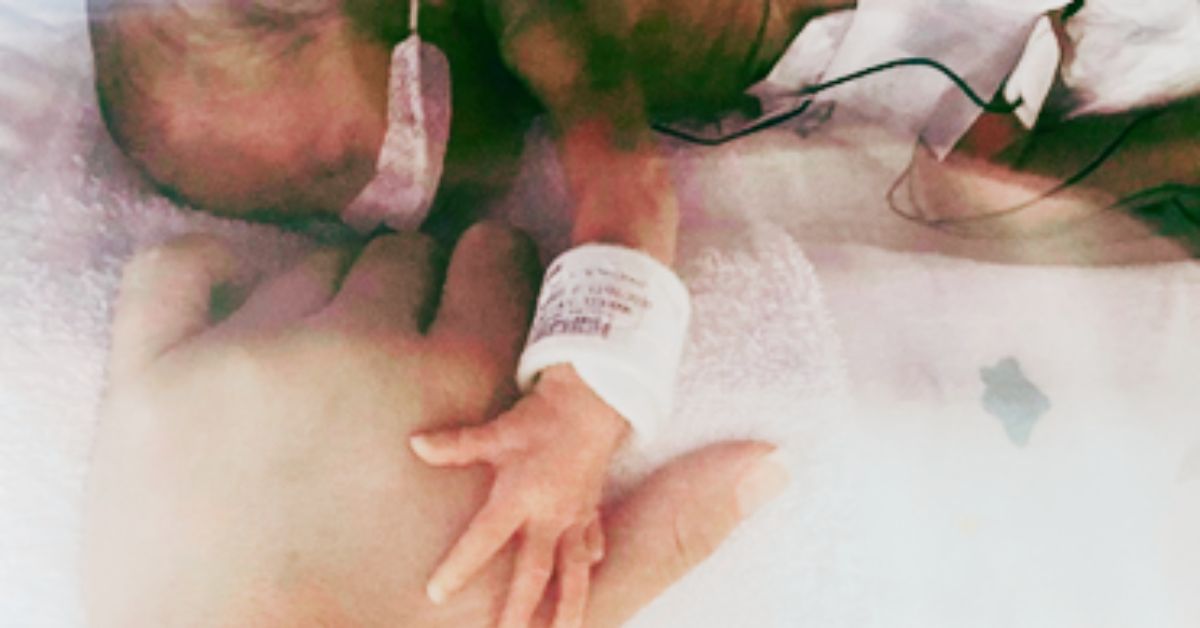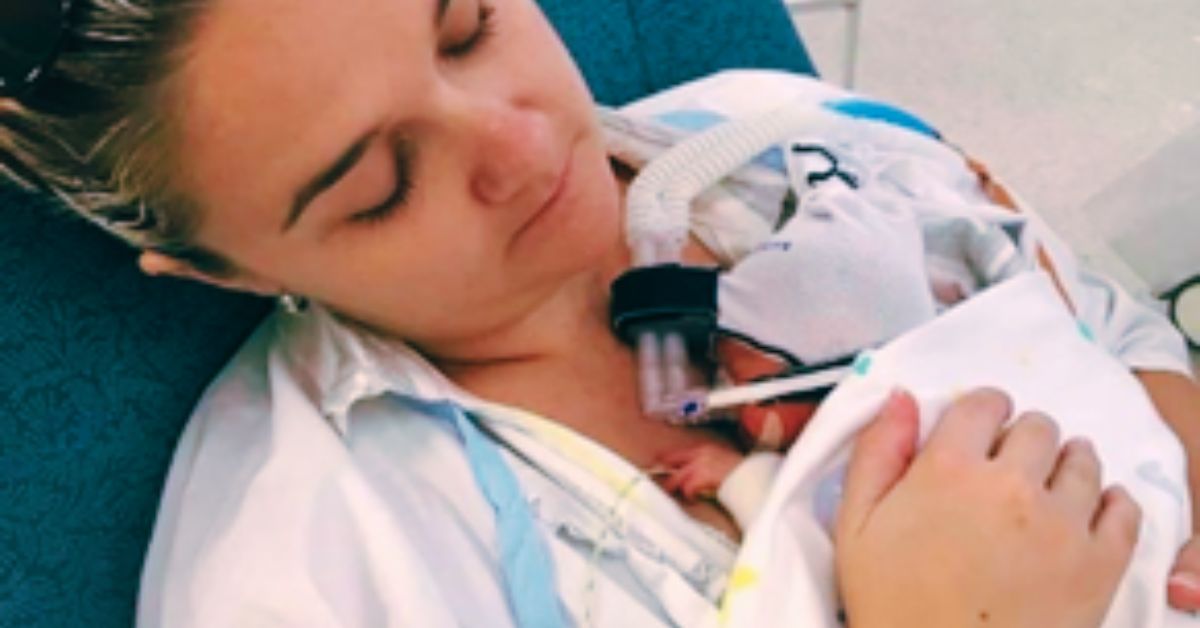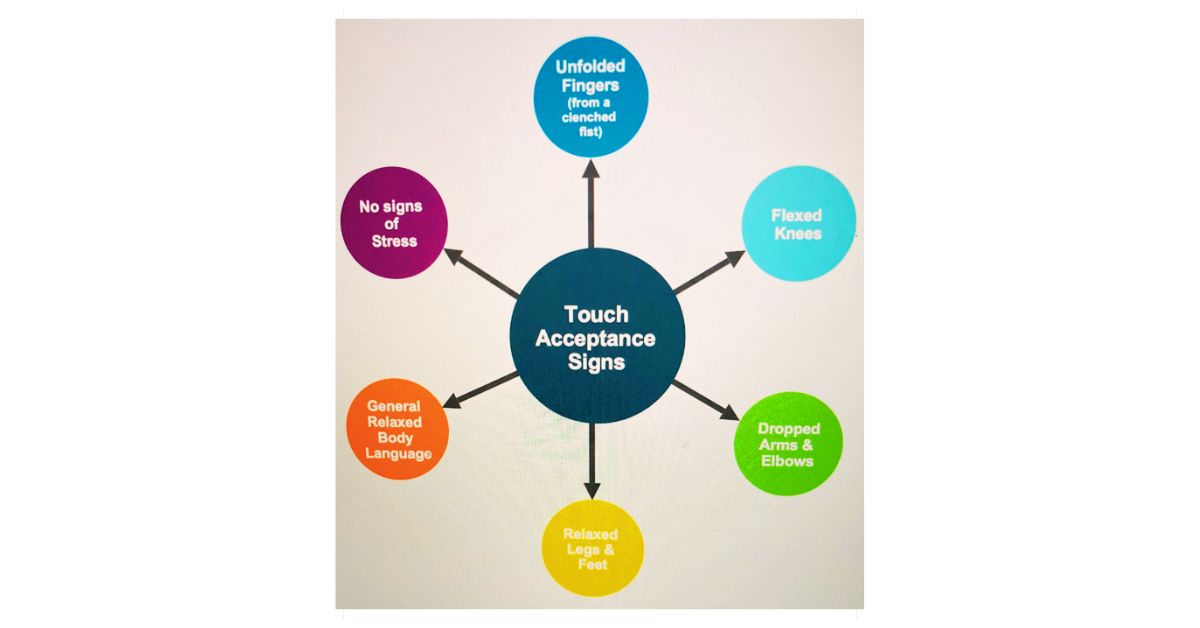Babies that are born before 36 weeks old are considered to be premature and can battle numerous complications. They tend to stay in hospital until their due date or until they are healthy enough to head home. From the time they are born, their experiences with touch can be stressful and not pleasant. They can encounter a number of heel pricks, being ventilated, having tubes inserted or even just having a bath, which can become very unwelcoming for a premature baby. Correct touch and infant massage therapy can have many benefits for the baby and the parents or caregiver.
How can I comfort my premature baby?
Hospitals aren’t usually a calming environment. It’s noisy, bright, has people coming and going at all hours of the day. This brings on many stresses to a newly born baby that is used to their mothers womb which was quiet and warm.
Ways to help calm your baby can be by using a dummy, quieten voices around them and dim the lighting, quietly reading or singing to them, comfort holding and when they are medically stable, provide kangaroo care. Infant massage can be carried out with the help from hospital staff once your baby is responding well to the comfort holding and the kangaroo care.
Always remember to watch your baby and their reactions. If whatever you are doing seems to calm them, keep doing it.
How can touching my baby help?
Touch is important to all human beings so it’s not surprising how effective touch can be for your baby. It is the beginning of the relationship for the parents. Premature babies tend to be taken away from their mothers very early on so they can receive the best medical treatment. The touch they are receiving from nurses and doctors is different to that from the mother or father. They learn that Mum and Dads touch is loving and gentle and that their caring touch is the start of the special bond with the infant.
Touching should be cleared by a nurse who will show you the best ways to do so. Start off small by holding their hand or by letting them hold your finger. Try saying something in a soft calm voice before touching them so they are aware that you are there.

Hand hugs or comfort holding is often the next stage to touching. Hands are usually cupping the baby's head, feet, bottom or back and constant pressure is maintained. To the baby, this feels like the parents are the walls of the uterus and that can be very comforting to the newborn. Do not stroke or pat while giving hand hugs. This can be overwhelming and painful to some babies as their skin is still very sensitive. One day the baby may enjoy their hand hugs and others they may not. It’s very important to always keep an eye on their body language and monitors while carrying out any form of touch. If you find that handling your baby seems to make them feel stressed and it’s not helping them relax, take some time out to slow down and relax yourself. Babies will pick up on if you yourself are feeling stressed and overwhelmed.
What Body Language should I be watching out for?
Premature babies have different body language to babies born full term. They are not strong or mature enough to have the same responses to that of a full term baby. They are very sensitive to noises, light and touch.
Some cues to keep an eye out for include slow breathing rate, change in skin colour and body twitching. Full term babies will cry to let you know if something is wrong but premature babies do not cry as often so it is important to learn their body language so you can tell how your baby is feeling. These cues will change the older and stronger they get, so keep in mind that every day will differ.
What is Kangaroo Care?
Kangaroo care is holding your baby in an upright position, skin to skin (baby in just a nappy) on your chest. Both parents can provide kangaroo care and are encouraged to do so as often as possible during the baby's hospital stay. This however may not be possible until the baby is medically stable to do so and will require the help from nursing staff. You may only be able to hold your baby for a few minutes a day and work towards longer intervals as the baby gets stronger.
What are the Benefits of Kangaroo Care?
Kangaroo care gives you a chance to bond with your baby and help you build your confidence in looking after your newborn. Your loving touch produces oxytocin which will make them feel loved and cared for. It’s your way to communicate with them through your smell, hearing your voice and feeling your touch.
Take the time to sit, relax and listen to them breathe. This will also lower stress levels for your baby and yourself.
Skin to skin will keep them warm and regulate their heart and breathing rate which will also help keep them calm and contented.
Your baby will tend to spend more time in a deep sleep during Kangaroo care as they feel warm and safe on their parents chest. For mothers, it can produce more breastmilk which can lead to a better outcome in breastfeeding and better success in baby gaining weight. Kangaroo care has long term physical and behavioural benefits.
Massage can also be good for babies during their hospital stay. They will have to be stable before introducing infant massage therapy, which your baby’s doctors and nurses will advise you if they are ready.

Infant Massage in Premature Babies
Infant massage can help overcome problems that can be related to early deprivation of touch. Preterm babies may be too small or too unstable in their first stage of life, therefore they are placed in a secure and comfortable environment within an incubator, which may lead to touching and holding to be very limited. Some babies may also associate touch as an act of aggression due to procedures performed and regular health checks. Baby massage can be a powerful tool to learn to create a new message to the infant, that touch can be healing, relaxing and comforting. It’s important to remember that every baby is different and how much massage they will handle will differ from day to day.
Is my Baby Ready to be Massaged?
If you find that your baby's responding well to comfort holding and kangaroo care, it might be time to move onto introducing massage. The baby's health status needs to be stable and approval from medical staff is recommended. Starting infant massage isn’t based around the age of the baby but on the potential that the baby will remain in a stable state while the massage is being performed.
**To be READY, the infant must be STRONG enough to REMAIN in a STABLE condition during the massage**
What are some signs I should be looking out for?
It’s recommended in note taking the sign responses from touch and from massage to help assist the health care team, parents and instructor. This will indicate how much the touch therapy and the massage therapy is helping.
Signs that you would like to be seeing include, unfolded fingers (from a clenched fist), flexed knees, dropped elbows and arms, relaxed legs and feet, body language is relaxed, zero signs of being stressed. It is suggested to keep the baby warm during touch and massage therapy and for the room to have low noise and dimmed lights.

Some stress signs to keep an eye on include yawing, looking away, hiccups, sniffing, coughing, sticking out their tongue, jaw dropping. These are mild stress responses and suggest that the massage should end soon.
Moderate to strong stress responses are sighing, crying, irritable and jerking movements, oxygen levels decreasing, breathing becoming shallow, heart rhythm slowing or quickening, skin becoming blotchy or changing colour. If any of these responses occur during touch or massage, stop immediately.
If at any stage you become unsure about your baby's responses, finish the therapy.
If in doubt…DON’T
What are the Benefits of Infant Massage?
Massage can have many benefits that can help your baby while they are in hospital.
Some benefits include:
- Bonding and attachment
- Improve parents confidence
- Improve understanding your baby’s body language and cries
- Relaxation
- Increase blood and lymphatic circulation
- Helps strengthen the immune system
- Enhances sleep patterns
- Increases weight gain
- Relieves discomfort
- Reduces anxiety and stress

Is there a Massage Program I can follow?
If your baby is in a stable condition, responding well to comfort holding and kangaroo care, stroking can gradually be introduced. The progression of the stroking should be at a very slow rate and the baby’s stress cues need to be closely monitored.
Step 1
omfort hold
Pression Sequence
Indian strokes on legs
Incorporation stroke
Comfort hold
Step 2
Add leg circles after Indian strokes (step 1)
Incorporation stroke
Warm abdominal area
Incorporation stroke
Comfort hold
Step 3
Introduce arm massage after abdominal
(arms may need to stay close to body for a sense of security)
Incorporation stroke - head to toe. Avoid chest area.
(allow your baby to be comfortable with massage routine before introducing chest massage as it can be a sensitive area for infants)
Comfort hold
Step 4
Add the rest of the strokes from a standard massage sequence
Remember to maintain a very slow stroking rate while performing the massage. It’s recommended not to add any Swedish strokes into the massage until all other strokes are being tolerated by the baby. You may find that by using a small bean bag to place the baby onto while doing a massage can help encourage a fetal-like position and can be comforting for your baby.
Foot massage is the final technique that is introduced as it is a sensitive area for premature babies. Hospitalised babies undertake many heel pricks whilst in their stay and tend to get very tender. It’s recommended that all other areas of massage have been introduced before foot massage is slowly introduced.
Step 1
Support at ankle, place the palm of hand just above the surface of the base of the foot
Step 2
Place a flat palm on the base of the foot, remaining still
Step 3
Cup the foot. Fingers coming over foot for closer contact
Step 4
Add the rest of a standard foot massage gradually. Start from the top of the foot and add the “heel to ball” and “walking” strokes last.

Things to remember
- It is important to avoid stress responses and not to over stimulate your baby. Try having only one form of stimulus during the therapy such as talking to your baby, having soft music playing in the background or making eye contact with them. A combination of these things is far too overwhelming to a premature baby. It is recommended to introduce just one form of stimulation at a time.
- Be well aware of your baby's stress and relaxation cues before introducing touch and massage therapy.
- If you are ever in doubt of any of your baby's responses, stop the therapy.
- Your baby needs to be in a stable condition before introducing touch or massage therapy. Remembering that before you start infant massage therapy, your baby must be strong enough to remain in a stable condition while receiving a massage.
- Start with comfort holding and kangaroo care before introducing massage therapy.
- Stay calm and relaxed while giving touch or massage therapy. Your baby will pick up on your emotions. Take some time out, slow down and breathe.
Infant massage is a great way to bond with your new born baby. It can give you as the parent a sense of being useful in a busy hospital environment. Your baby will learn that your touch is different to that of the doctors and nurses and that your touch is loving and nurturing.
Touch and massage therapy is your time to start your beautiful bond with your new bundle of joy, so it should be a fun and relaxing experience. Not all experiences to touch for a premature baby should have a negative outcome which is why touch and massage therapy can be a very powerful tool to provide throughout your infant's hospital stay.
References
www.swneonatalnetwork.co.uk. 2023. No page title. [ONLINE] Available at: http://www.swneonatalnetwork.co.uk/media/28779/benefits_of_infant_massage.pdf. [Accessed 22 April 2023].
Raising Children Network. 2023. Raising Children Network. [ONLINE] Available at: http://www.raisingchildren.net.au. [Accessed 22 April 2023].
Kangaroo Care for Your Infant. 2023. Kangaroo Care for Your Infant. [ONLINE] Available at: https://www.nationwidechildrens.org/family-resources-education/health-wellness-and-safety-resources/helping-hands/kangaroo-care-for-your-infant. [Accessed 22 April 2023].
Raising Children Network. 2023. NICU: calming sick or premature babies | Raising Children Network. [ONLINE] Available at: https://raisingchildren.net.au/newborns/premature-babies-sick-babies/connecting-communicating/helping-baby-feel-calm-in-the-nicu. [Accessed 22 April 2023].
Raising Children Network. 2023. Sick or premature babies: touch & holding | Raising Children Network. [ONLINE] Available at: https://raisingchildren.net.au/newborns/premature-babies-sick-babies/connecting-communicating/touch-massage-in-the-nicu. [Accessed 22 April 2023].
Raising Children Network. 2023. Premature babies: body language | Raising Children Network. [ONLINE] Available at: https://raisingchildren.net.au/newborns/premature-babies-sick-babies/connecting-communicating/premature-body-language. [Accessed 22 April 2023].
Touching and holding your baby in the NICU | March of Dimes. 2023. Touching and holding your baby in the NICU | March of Dimes. [ONLINE] Available at: https://www.marchofdimes.org/find-support/topics/neonatal-intensive-care-unit-nicu/touching-and-holding-your-baby-nicu. [Accessed 23 April 2023].
Life's Little Treasures. 2023. Kangaroo Care - Life's Little Treasures. [ONLINE] Available at: https://lifeslittletreasures.org.au/information/information-for-families/survival-guide-to-nicu-and-special-care/kangaroo-care/. [Accessed 23 April 2023].
Massage for Premature or Preterm Babies - HealthXchange . 2023. Massage for Premature or Preterm Babies - HealthXchange . [ONLINE] Available at: https://www.healthxchange.sg/women/post-pregnancy/massage-premature-preterm-babies. [Accessed 23 April 2023].
IMIS training manual 3rd edition - Infant massage information service 2017